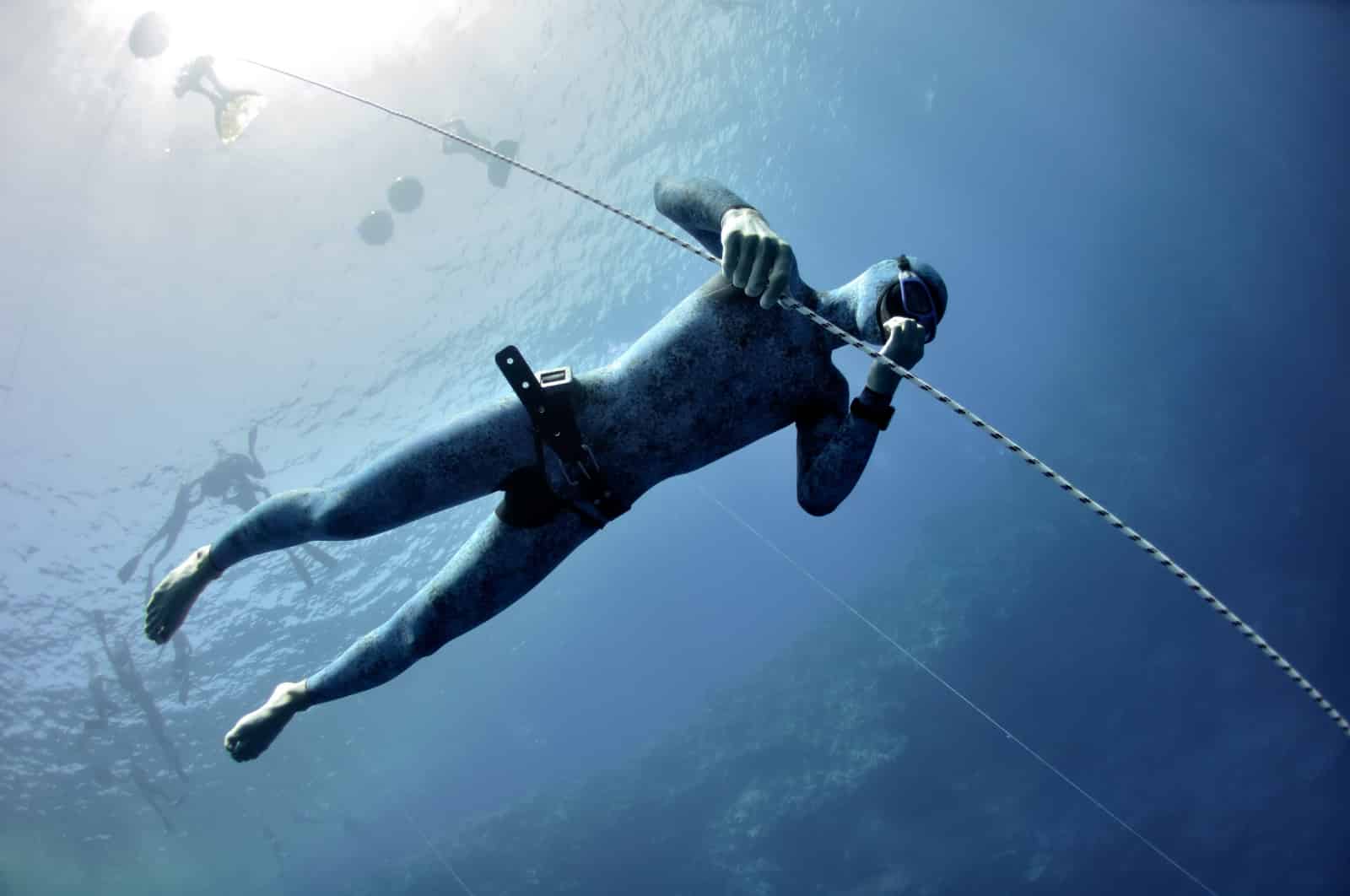Freediving - what is freediving?
Freediving is an ancient activity that has been practiced by humans for thousands of years. It involves diving underwater without the use of any breathing apparatus, relying solely on one’s own breath-holding abilities to stay submerged for extended periods of time. Freediving can be used for fishing, exploration, and recreational activities such as freediver photography or free-dive spearfishing. Throughout history, breath-hold diving has also been used in military operations and search & rescue missions.

In ancient times, freedivers were often employed to collect food from the sea floor or hunt fish with spears and nets. In more recent centuries, freedivers have become more specialized in their craft; they now compete in international competitions and demonstrate remarkable feats of breath-hold endurance while exploring some of the world’s deepest caves and wrecks.
The modern-era freediver benefits from improved training techniques, safety protocols, and equipment advancements which allow them to dive deeper than ever before while staying safe in extreme depths underwater. This article will explore the fascinating history of freediving – from its early beginnings to its current state as a popular sport around the world today!
Freediving has its origins in the ancient world, with evidence of freediving activities found in cultures as far back as 5,000 years ago. Egyptian texts from around 4500 BC describe freedivers diving to depths of up to 40 meters and holding their breath for several minutes at a time. Later, freediving was adopted by the Minoan civilization on Crete Island and by the Greek city-states of Athens and Sparta. They used freedivers to collect sponges which were then used for everything from cleaning dishes to creating armor.

In more recent centuries freediving diversified into different specialties such as deep sea diving, pearl fishing, and spearfishing. Freedive competition began in 1949 with the first modern freediving competition in Nice, France, and soon spread throughout the world.
Today breath-hold diving is a popular recreational activity as well as a competitive sport with freedivers from all over the globe competing to set new records for depth and time spent underwater. It’s also gaining popularity as an extreme adventure activity with freediver photographers capturing stunning images of marine life far below the surface. Freediving continues to evolve and captivate its practitioners in unique ways each day!
The history of freediving is long and varied, but the future looks even brighter. With improved safety measures and freediving competitions growing in popularity each year, freediving will only continue to captivate its practitioners for many years to come!
Freediving is a timeless activity that has been practiced around the world for thousands of years. From its early beginnings as an ancient means of gathering sustenance from the sea floor, freediving has evolved into a popular recreational sport enjoyed by freedivers from all over the globe. Today’s freedivers can benefit from improved safety protocols, modern training techniques, and advanced equipment allowing them to safely explore some of the deepest reaches of our planet’s oceans. Freediving is both a sport and an art form that will continue to captivate its practitioners for many years to come!

Freediving Competitions:
– Static Apnea: competitors attempt to hold their breath underwater for the longest amount of time, without any movement.
– Constant Weight Apnea: divers must reach a set depth and return back up without using any artificial means (fins or weights).
– Dynamic No Fins Apnea: swimmers compete in an unassisted swim with no fins.
– Vertical Blue Free Immersion World Championship: divers use a rope to descend and ascend from the depths.
Q&A Freediving
Freediving, the practice of diving underwater without the use of breathing apparatus, carries inherent risks and can be dangerous if not approached with proper training, safety measures, and caution. Some of the risks associated with freediving include:
- Shallow water blackout: This occurs when a diver loses consciousness due to lack of oxygen while ascending from a dive. It is one of the most common causes of freediving accidents and can be fatal if the diver is not quickly brought to the surface and given appropriate first aid.
- Barotrauma: Changes in pressure during descent and ascent can cause injuries to air-filled spaces in the body, such as the lungs, sinuses, and ears. Proper equalization techniques and slow ascents can help minimize this risk.
- Hypoxia: Prolonged breath-holding can lead to low oxygen levels in the body, which may result in dizziness, confusion, or unconsciousness. Proper training in breath-hold techniques and knowing one’s limits are essential in reducing this risk.
- Nitrogen narcosis: Although less common in freediving compared to scuba diving, nitrogen narcosis can still occur at depths greater than 30 meters (100 feet). This condition causes impairment of cognitive function and can lead to poor decision-making and risky behavior underwater.
- Drowning: Freediving always carries the risk of drowning, especially if a diver experiences a shallow water blackout, hypoxia, or other complications.
To minimize the risks associated with freediving, it is essential to:
- Receive proper training from a certified freediving instructor
- Dive within your limits and gradually progress to deeper dives
- Always dive with a buddy who is trained in rescue techniques
- Follow safety protocols, such as using a surface marker buoy and dive line
- Monitor your physical and mental condition before and during a dive
While freediving can be a rewarding and exhilarating activity, it is crucial to approach it with respect for the inherent risks and prioritize safety at all times.
The golden rule in freediving is “Never Freedive Alone,” also known as the “One Up, One Down” rule. This principle emphasizes the importance of always having a dive buddy who is trained in freediving safety and rescue techniques.
The “One Up, One Down” aspect of the rule highlights that while one diver is underwater, the other diver should remain at the surface, monitoring their buddy’s dive and being prepared to provide assistance in case of an emergency. This practice ensures that if any issues arise, such as a shallow water blackout or loss of consciousness, the surface diver can immediately initiate rescue procedures and provide help.
Following the golden rule of freediving is crucial for ensuring the safety of all participants and minimizing the risks associated with the sport.
The number 1 rule in freediving, often referred to as the golden rule, is “Never Freedive Alone.” This rule emphasizes the importance of always having a dive buddy who is trained in freediving safety and rescue techniques. While one diver is underwater, the other diver should remain at the surface, monitoring their buddy’s dive and being prepared to provide assistance in case of an emergency. Adhering to this rule is crucial for ensuring the safety of all participants and minimizing the risks associated with freediving.
The number 1 rule in freediving, often referred to as the golden rule, is “Never Freedive Alone.” This rule emphasizes the importance of always having a dive buddy who is trained in freediving safety and rescue techniques. While one diver is underwater, the other diver should remain at the surface, monitoring their buddy’s dive and being prepared to provide assistance in case of an emergency. Adhering to this rule is crucial for ensuring the safety of all participants and minimizing the risks associated with freediving.
Share This Post
More To Explore

AIDA Depth World Championship Limassol 2023 – Great Atmosphere During the Day 1
During the first day of the AIDA Depth World Championship Limassol 2023, the ladies competed in the Constant Weight No Fins – CNF discipline.

Italian freediver Andrea Zuccari has been missing at sea and presumed dead
Sad news has been reaching us since yesterday that Italian freediving champion Andrea Zuccari has been reported missing at sea.

The Deepest Breath – New amazing freediving documentary on Netflix
The Deepest Breath is a unique documentary film that takes the viewer into the remarkable world of freediving.

Vertical Blue 2023 – doping bust-up of two freedivers ahead of next edition of the event
Two freedivers from Croatia, including the holder of the current AIDA World Record in the Free Immersion – FIM, Petar Klovar, have been banned for doping from the Vertical Blue competition at Bahamas.



